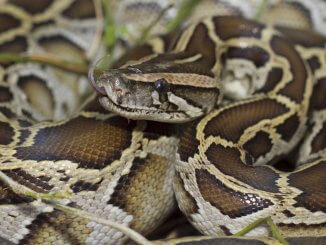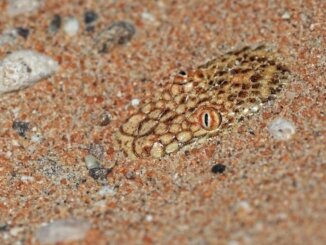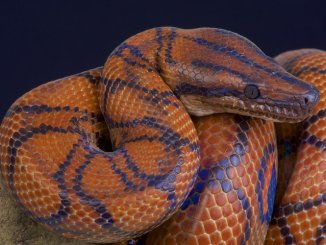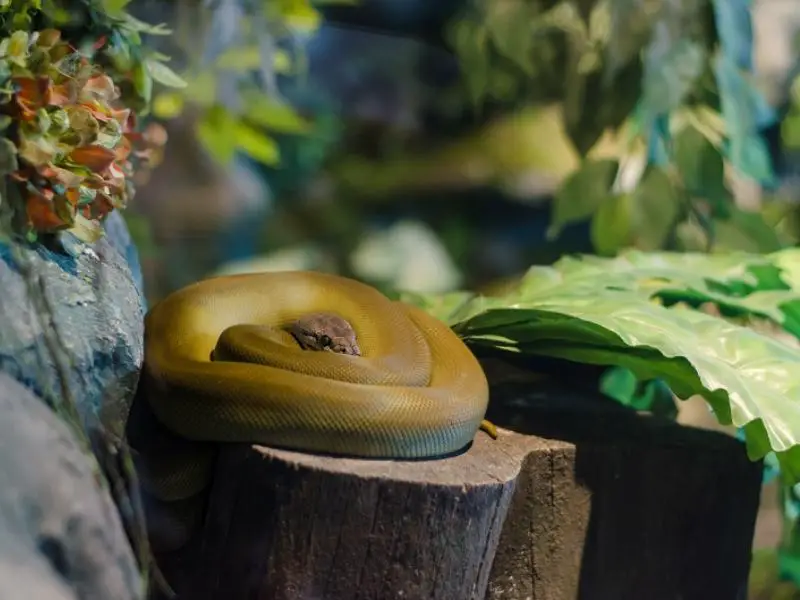
The olive python is a non-venomous snake that can grow up to 13 feet long, and is olive-colored with a white belly. This ground-dwelling python is native to Northern Australia in rocky areas near water sources.
Olive pythons are recommended pets for more advanced hobbyists because of the snake’s large size, extensive care requirements, and aggressive feeding habits. These pythons need a custom-built enclosure that is cleaned regularly and fitted with a well-maintained heating setup.
Olive Python Overview
| Common name | Olive python |
| Scientific name | Liasis olivaceus |
| Natural habitat | Near bodies of water in rocky terrains, grasslands, farmland, and shrubland in Northern Australia |
| Adult size | 8–13 feet |
| Average lifespan | 20–30 years |
| Diet | Small mammals, rodents, birds, bats, and other reptiles |
| Housing | A simple vivarium measuring at least 8 x 4 x 3 feet, with minimal decorations, and a gradient temperature of 77 to 95°F |
| Experience level | Intermediate to expert reptile keeper |
Origin
The olive python (Liasis olivaceus) is native to Northern and Western Australia, including Western Queensland. The pythons are usually found hiding in crevices, logs, or caves near sources of water in dry, rocky terrains and gorges, farmland, grassland, and shrubland.
A subspecies of the olive python, the Pilbara (Liasis olivaceus barroni), is so-named because its habitat has been reduced to the Pilbara region due to low reproduction rate and decline in prey.
Appearance and Behavior
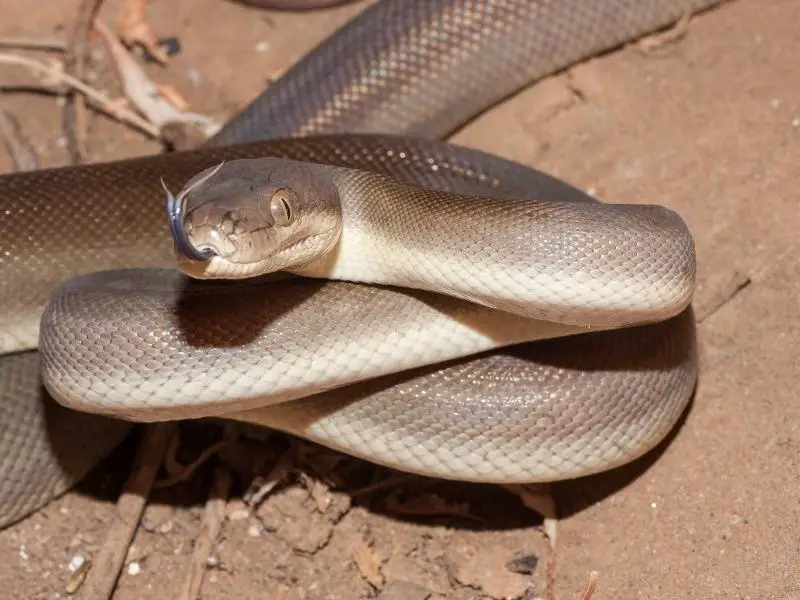
The olive python is an olive-green or chocolate-brown snake with many small dorsal scales that give its body an exceptionally smooth appearance. The python’s belly is cream or white, and its lips are lightly dotted with pale brown and gray.
Olive pythons are often mistaken for the venomous king brown snake, and pointlessly killed.
Female olive pythons are only slightly longer than the males, and both have the same coloring.
Size and Lifespan
The olive python is the third largest snake in Australia, often growing longer than 13 feet, but averages around 8 feet. This python’s body is slimmer than many other snakes of the same length.
The lifespan of olive pythons isn’t clear, but most reptiles live for 20 to 30 years, and some olive pythons have lived for 12 years in captivity. Keep the reptile well-fed with a healthy diet, and keep its enclosure clean to ensure the snake’s longevity.
The python sheds as it grows – shedding on average once every four to eight weeks. Encourage the olive python’s easy, healthy shed by keeping its tank clean and providing fresh water.
Temperament
Olive pythons are curious, calm, and friendly in captivity, however, these snakes are aggressive and opportunistic feeders and can mistake anything that enters the tank for food. Juveniles are more likely than adults to bite.
These snakes are solitary night-dwellers that enjoy exploring in cooler night temperatures. The olive python hides in crevices during the day and lays under the water when waiting to ambush prey that comes to drink.
Loud noises and children in the house stress the olive python and cause it to hide underwater. Olive pythons deliver a painful, but non-venomous bite when feeling threatened.
Housing Olive Pythons
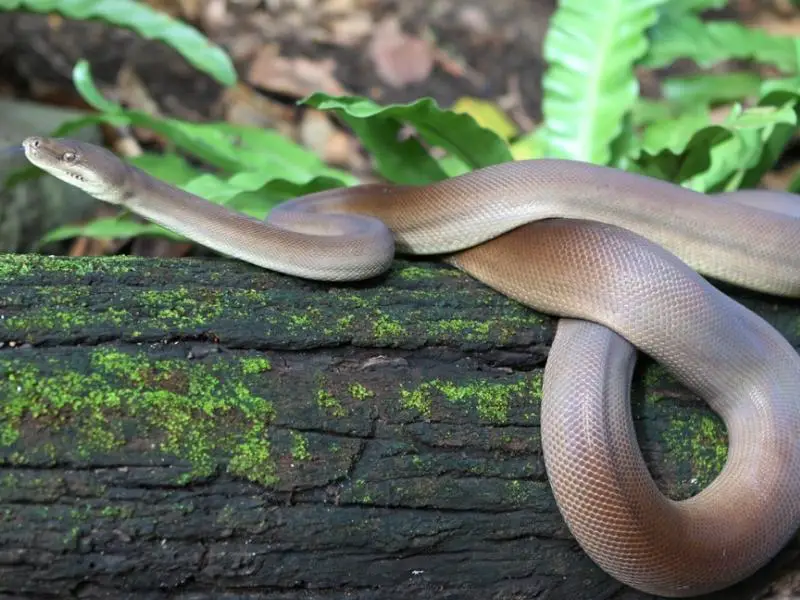
The olive python’s captive environment should be simple, with no sharp objects that can harm the snake.
A custom-built vivarium is usually required to accomodate this large snake. The enclosure should contain a large water source for the snake to swim and bathe in, and to drink from.
Enclosure size
Olive pythons need a large enclosure that is at least 8 x 4 x 3 feet, but preferably larger. The enclosure should be large in width and length to allow this ground-dwelling snake to explore. The python occasionally enjoys climbing, so include logs or branches in the enclosure.
Juvenile olive pythons prefer a smaller vivarium that measures about 4 x 2 x 2 feet, with several hiding spots.
Lighting
Olive pythons are nocturnal. Locate the snake’s enclosure in a spot that receives partial sunlight throughout the day, or add UVA and UVB to mimic a natural day and night cycle.
Temperature and Humidity
In the wild, olive pythons stay warm by laying on sunny rocks. Add a heat source to the snake’s enclosure and monitor a temperature gradient.
Create a temperature gradient in the enclosure using spot bulbs — that are out of reach of the snake — and underground heating pads or cables. Set the temperature on the colder side of the enclosure to 77°F, while keeping the warmer side of the enclosure at 95°F.
Monitor the enclosure’s temperature with high-quality thermostats.
Reduce the enclosure’s overall temperature to 70°F at night. Change the daytime heating hours according to the season, with 14 hours of daytime heat during summer and 9 hours of daytime heat during winter.
Substrate and Decoration
Olive pythons adapt to several types of substrate. Hobbyists often use newspaper or butcher paper in the snake’s enclosure because it’s easy to clean. Use other substrates such as fir tree bark like Reptibark, cork bark, aspen snake bedding, synthetic grass, gravel, or coconut fiber in the vivarium for a more natural enclosure.
Add at least 3 inches of substrate that covers the entire floor of the enclosure. The vivarium should be kept simple, with rocks and logs for the python to hide under and climb. Avoid placing sharp objects in the enclosure that can harm the snake.
Place a spill-proof water source in the enclosure large enough for the olive python to submerge in, filled with fresh, clean water. Ensure the dish is located where the snake can easily slither in.
Cleaning
Spot clean the vivarium whenever the olive python has made a mess, and clean the enclosure thoroughly once a month. Clean with a reptile-safe disinfectant, such as F10. Spot-clean natural substrate and replace newspaper when it’s soiled, and fully replace the substrate every two months.
The python should be removed from the enclosure during deep cleans.
Olive Python Care
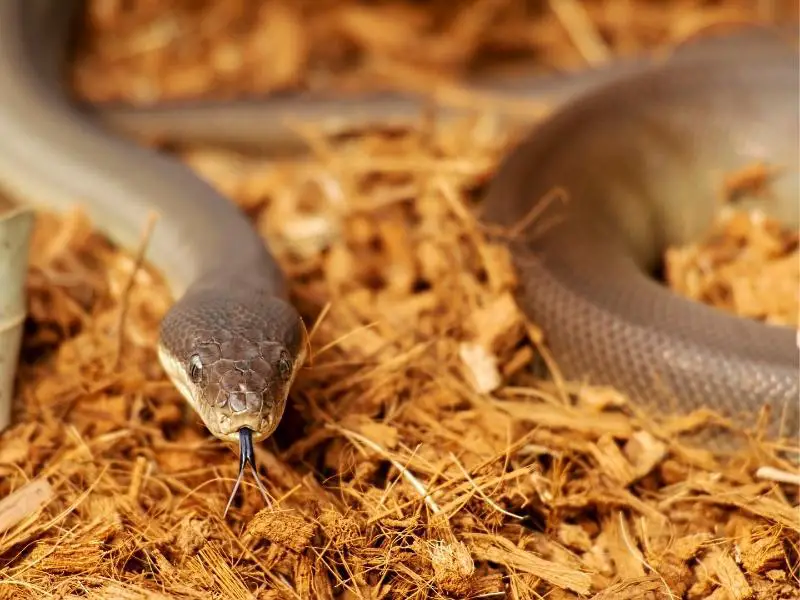
Olive pythons are docile pets when handled correctly from a young age, and are best suited to intermediate and expert hobbyists. These snakes need specialized care because of their large size and aggressive eating habits.
Food and Water
Olive pythons are opportunistic eaters and try to eat anything that will fit in their mouths. Feed adult olive pythons fully defrosted birds, rodents, quail, and frogs once every two or three weeks.
Any food given to the snake should not be bigger than the snake’s girth at its largest part. Feed juvenile olive pythons one or two pinky mice or small rats once or twice a week until the juvenile pythons are large enough to enjoy a more varied diet.
Don’t feed captive olive pythons live food, because the fight for the prey in the confined space can injure the snake. Place food in the enclosure using tongs to prevent the snake from biting your hand.
Keep the python’s water bowl filled with clean water. Olive pythons are known to defecate in water.
Handling
Handle the olive python often while it’s young to get it used to human touch. Take care because the juvenile is likely to bite before it’s used to human handling. Once the olive python is used to handling, it may enjoy the attention
Use a hook to initially lift the snake out of the enclosure before handling it so the snake doesn’t confuse the introduction of your hand into its enclosure as incoming food.
During handling, don’t release the snake on the floor, because the snake may be difficult to recapture and can injure itself or become trapped in small spaces.
Don’t handle the snake directly before feeding, for up to 72 hours after feeding, or during the snake’s shedding cycle.
Common Health Issues
Olive pythons can hide the early stages of health issues, so watch for subtle signs that signal a problem and seek veterinary care if any of the following issues occur:
- Skin disorders — Reduce the snakes’ ability to shed well. Visible signs include shedded skin that is in pieces, or patches of dry, flaky skin attached to the body
- Mouth infections — Cause bleeding gums, the snake’s inability to open its mouth, and mouth swelling. Symptoms of mouth infections include loss of appetite, pus from the mouth or nose, and visible, dead tissue in the mouth
- Internal parasites — Cause internal swelling and can be passed on to other snakes through fecal matter. Evidenced by lethargy, weight loss, reproductive issues, and partial paralysis
- Eye disorders — Affect one or both eyes, and are evidenced by eye swelling, cloudy eyes, and growths around the eyes
- Respiratory infections — Can create breathing problems such as wheezing, nasal discharge, inactivity, and loss of appetite
- Neurological disorders — Cause the snake to experience awkward movements, convulsions, and tremors
Quarantine
Quarantining a new reptile is necessary to prevent any contagious pathogens from infecting other reptiles already living in the home. Generally, it is recommended to quarantine a new snake for a minimum of six months to monitor it for disease and illness.
Keep the quarantined olive python in a separate room without any shared airspace between the python and the established reptiles to prevent airborne diseases from spreading.
Only handle the quarantined reptile after all contact with the non-quarantined animals, and replace your clothing and disinfect your hands in between species to prevent spreading disease.
Breeding
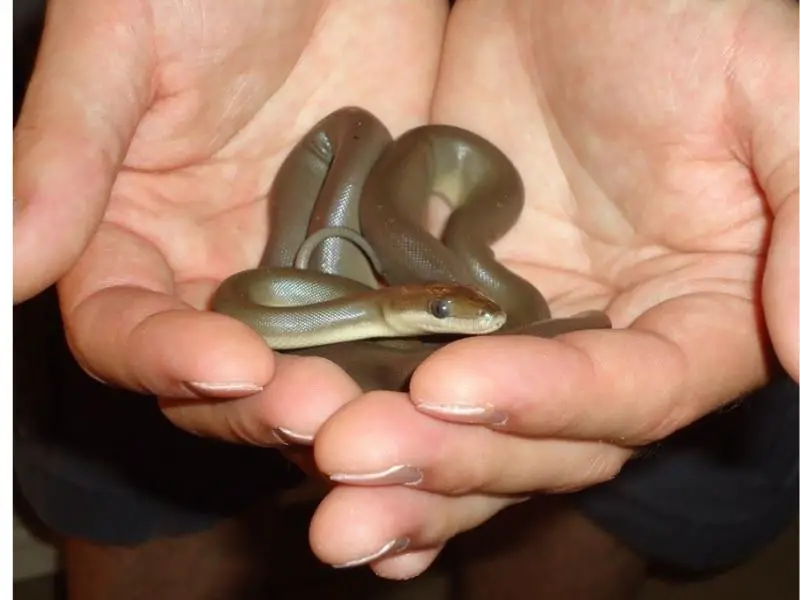
Olive pythons begin breeding naturally in May and continue until mid-July. In captivity, introduce the female python into the male’s enclosure in May, and remove her in mid-July.
When mating is complete, the gestation period lasts for 81–85 days, during which the female becomes highly active and searches for a spot to lay her eggs.
Upon finding a reclusive spot, the female lays a clutch of 12–40 eggs. The eggs hatch after an incubation period of about 50 days.
Place hatchlings in small separate containers with a temperature of 82°F, and add newspaper and a small water bowl along with a small cave or hiding spot. When the juveniles reach full maturity, place them in larger enclosures.
Choosing and Buying an Olive Python
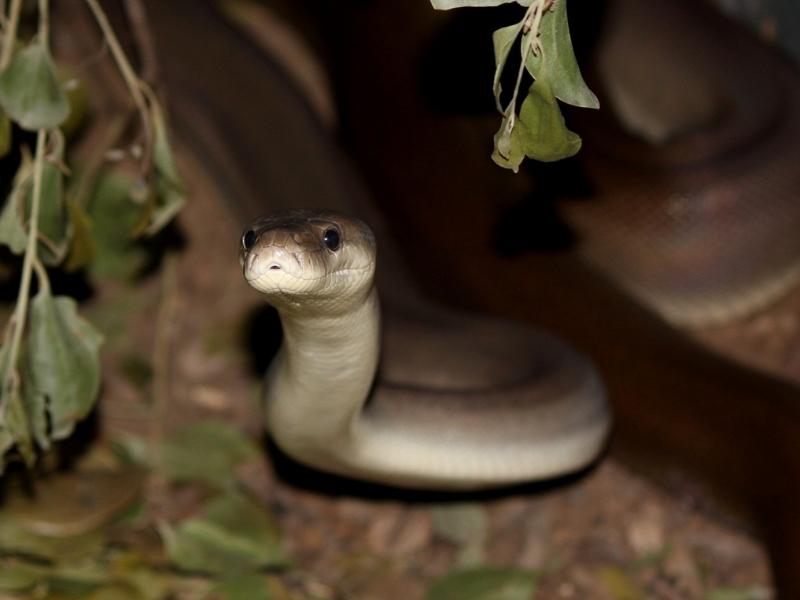
An olive python costs between $500 and $5,000 at reputable pet stores and breeders. The snake is noted as a vulnerable species, and a specialized license is needed to own one.
Always choose captive-bred olive pythons, because wild-caught pythons can die from the stress caused by captivity. Wild-caught reptiles may also have diseases and illnesses that are unknown to the new owner.
When buying an olive python, watch for visible signs of ill health such as cloudy eyes, lethargy, inability to eat, and swelling.

